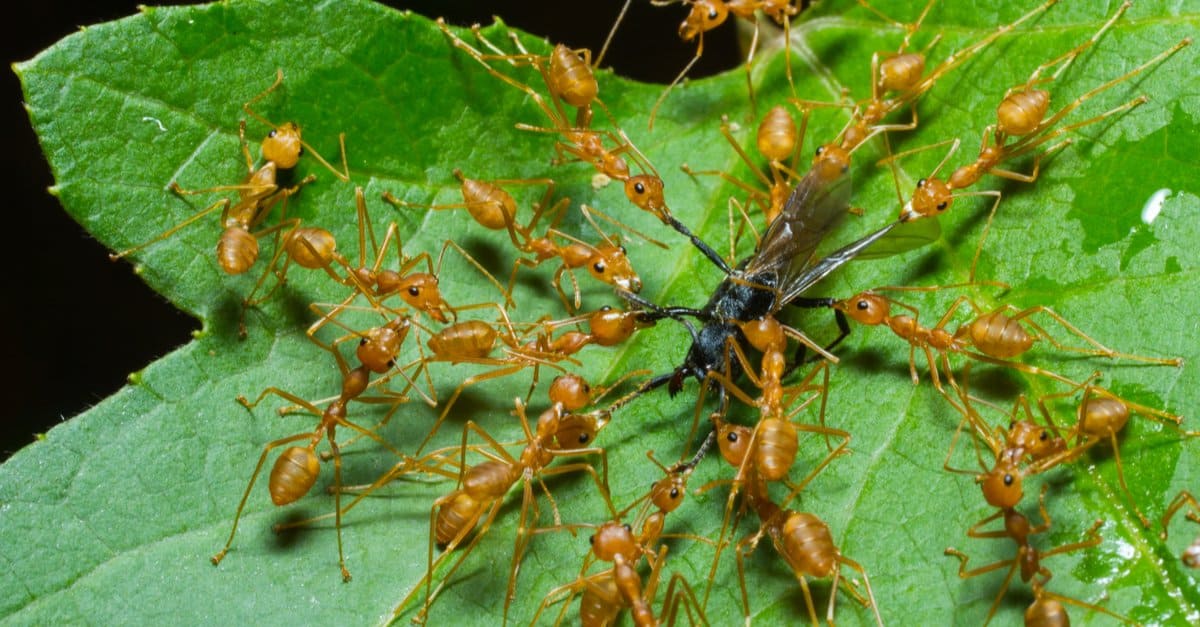Spider mites are a common garden pest that can quickly get out of control and damage plants. These tiny arachnids suck juices from leaves, causing them to dry out and die. With fast reproduction cycles, spider mite populations grow exponentially in warm, dry conditions.
Many gardeners seek natural ways to control spider mites without resorting to chemical pesticides This has led to an intriguing question – do ants eat spider mites? There has been much debate over whether ants can be an effective form of natural pest control against spider mites.
The Theory Behind Using Ants for Pest Control
The idea of using ants as a biological control method is based on a phenomenon called trophobiosis. This refers to a symbiotic relationship where ants protect other insects like aphids, feeding on the honeydew they excrete. By tending aphid colonies, the ants get an easy meal while the aphids gain protection from predators.
Some gardeners theorized that ants may offer the same protection services to spider mites happily feasting on them in exchange for access to the sweet honeydew. Anecdotal evidence even circulated online of ants swarming heavily mite-infested leaves and “eating” them.
Could ants be the natural predator we need for controlling spider mites? Let’s examine if the theories align with scientific evidence.
What the Research Shows on Ants and Spider Mites
A number of studies have investigated whether ants really prey on spider mites or just happen to be attracted to infested plants. The results show mixed evidence on ants controlling mites.
One study found that spider mites were 3-4 times more abundant on cotton plants with ants than on plants without ants. The ants appeared to be simply feeding on the honeydew produced by the mites rather than preying on them.
However, another study on cassava plants did show significantly fewer mites on plants with ants present. The researchers concluded that the ants were likely preying on mites, beneficially reducing their numbers.
There is also evidence that different ant species behave differently. For example, the ant Tetramorium caespitum was found to protect spider mites on strawberry plants while Lasius niger preyed on them.
Overall, the research shows mixed results on using ants for mite control. Their predatory behavior seems to depend on the ant and mite species involved as well as characteristics of the plant habitat. Natural trophobiosis is not guaranteed to occur.
Practical Considerations for Using Ants in Pest Control
While the science is still unclear, there are a few practical considerations if you want to try attracting ants to manage spider mites:
-
Focus on pest ant species – Certain ants are more likely to prey on pests than others. In particular, avoid attracting fire ants which are an aggressive, invasive species.
-
Encourage habitat – Provide food like honey or sugar water to attract desirable ant colonies. Ensure easy access to plants by keeping areas clear of debris piles.
-
Monitor activity – Check plants frequently to see if ants are actually preying on mites or just collecting honeydew secretions without impacting populations.
-
Combine with other methods – Don’t rely solely on ants for mite control. Use other proven methods like introducing predatory mites, hosing plants down, or using insecticidal soap.
-
Prevent ant farms – Discourage ants from farming sap-sucking insects like aphids which can cause separate damage to plants.
Using Predatory Mites for Natural Pest Control
While the jury is still out on ants, another natural option for controlling spider mites is using predatory mites. These mites specifically target spider mites and are commercially available from garden suppliers.
Species like Phytoseiulus persimilis and Neoseiulus californicus have high feeding rates on pest mites. They can quickly knock down populations when released onto infested plants. Predatory mites continue working even after the spider mites are gone by entering a dormant state and awaiting their return.
The benefits of predatory mites include:
- Highly effective even at low populations
- Establish breeding colonies that provide ongoing control
- Tolerant to many pesticides if combined with chemical treatments
- Safe for use on edible plants
The main downside is that predatory mites can be pricey compared to ants. However, their proven feeding behavior makes them a lower risk investment for most growers.
An Integrated Pest Management Approach is Best
At the end of the day, relying solely on any single biological control method is risky. The most effective spider mite control integrates multiple tactics as part of an IPM plan:
- Monitor plants regularly for early detection
- Dislodge mites with directed sprays of water
- Apply insecticidal soap or oils to suffocate mites
- Release predatory mites or insects like ladybugs
- Use reflective mulch to disturb mites
- Remove heavily infested leaves/plants to prevent spread
Combining these mechanical, physical, biological, and chemical controls provides layers of defense against spider mites. Ants may play a helpful role, but should not be the only tactic in your arsenal against these devastating pests.
Do ants eat spider mites? The question continues to be debated by gardeners and researchers. Some ant species do appear to prey on mites in certain conditions. However, results are mixed on whether ants can control mite infestations in real world application.
While ants may offer some natural pest control benefits, proven methods like introducing predatory mites are a safer bet. The best defense is an integrated pest management plan that combines multiple tactics against spider mites. Careful monitoring and early intervention is key to staying on top of mite problems before they get out of hand.
Super Simple Spider Mite Control and Prevention
FAQ
Do ants like spider mites?
What eats spider mites?
Do ants kill mites?
What do spider mites hate?
- A Complete Guide to Caring for Yuki Cherry Blossom Shrub - January 23, 2025
- Identifying Red Hot Poker Seeds: What to Look For When Harvesting Torch Lily Pods - January 23, 2025
- A Complete Guide to Harvesting Evening Primrose Seeds - January 23, 2025

